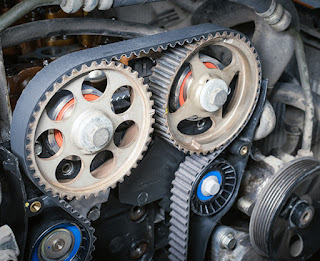What Does A Timing Belt Do?
The Timing Belt Is A Very Important Part Of Your Car.
What we all want is to protect our vehicles and we all make sure to keep them maintained properly against wear and tear, and unwanted breakdowns. It's no surprise to learn that one of the greatest potential dangers to a high-mileage vehicle is also one of the least well-known. While we try to prevent engine or transmission breakdown, the end to many older or high mileage cars is the failure of the timing belt. To understand the importance of the timing belt and how we can prevent it from failing, we first need to learn a little bit about what it does for specific car models when it comes to the life expectancy of the belt.
The timing belt is the belt that controls the camshafts in your engine and maintains the entire operation running in unison. Timing belts are in all engines with overhead cams and are essential to keep these cams turning at the right time to keep the engine running properly. The camshaft is the shaft that opens and closes the intake and exhaust valves in an engine. These valves let air in to create combustion and vent the exhaust that comes from those explosions. The timing belt must be properly adjusted to be in time with the movement of the pistons.
The Two Types of Gasoline Powered Car Engines.
When it comes to timing belts there are two types of engines "interference" and "non-interference. Interference engines have a very, very small amount of space between the valves and pistons, while non-interference engines tend to have a lot more room.
The different types of engines make a major difference when a timing belt failure happens in your engine. An interference engine has a small space between the valves and pistons. A slip or break in the belt can send a piston crashing into an open valve. This is equivalent to the engine self-destructing, and becoming an unusable mess of metal. Timing belt failure in a non-interference engine will not be as damaging. It can still cause a considerable amount of damage to the engine components. More often than not a timing belt failure in a non-interference engine will not cripple the motor.
No matter what type of motor is in your car, a failure of the timing belt will cause the engine to stop running for good. This means you will have to call a tow truck to come to pick up your non-running vehicle.
Sounds like a nightmare, luckily a timing belt failure is somewhat easy to prevent. It may not be the cheapest repair in the world. But it's a better option than purchasing a new car or a new engine.
Check out a more detailed look into How A Timing Belt Replacement Works.
How To Tell Whether A Timing Belt Needs Replacing.
Checking if a timing belt needs replacing is not easy. When your timing belt is changed, it's best to write down the current miles in your records. A used car may have a sticker located under the hood showing the miles of the last timing belt change. If you cannot find this sticker then it may be better to have the belt changed just to be on the safe side. The owner's manual for your car should tell you when the belt needs changing.
A local mechanic or car dealership can advise you when the belt should be changed. A timing belt should be changed every 60,000 to 75,000 miles, but some are designed to last up to 100,000 miles. Regardless, it's best not to let a belt go more than 80,000 miles or so. Even if the recommended change point is a lot higher. Changing your belt early is best for the longevity of your car's engine. A little paid early on can save you a lot of money in the future. Getting your timing belt changed may keep you from having to get a new car in the future.
Even if you get your oil changed every 3,000 miles and do all of your maintenance and service on time. Nothing can save your car from a failed timing belt. Make sure to get your timing belt replaced regularly and by a certified mechanic.



